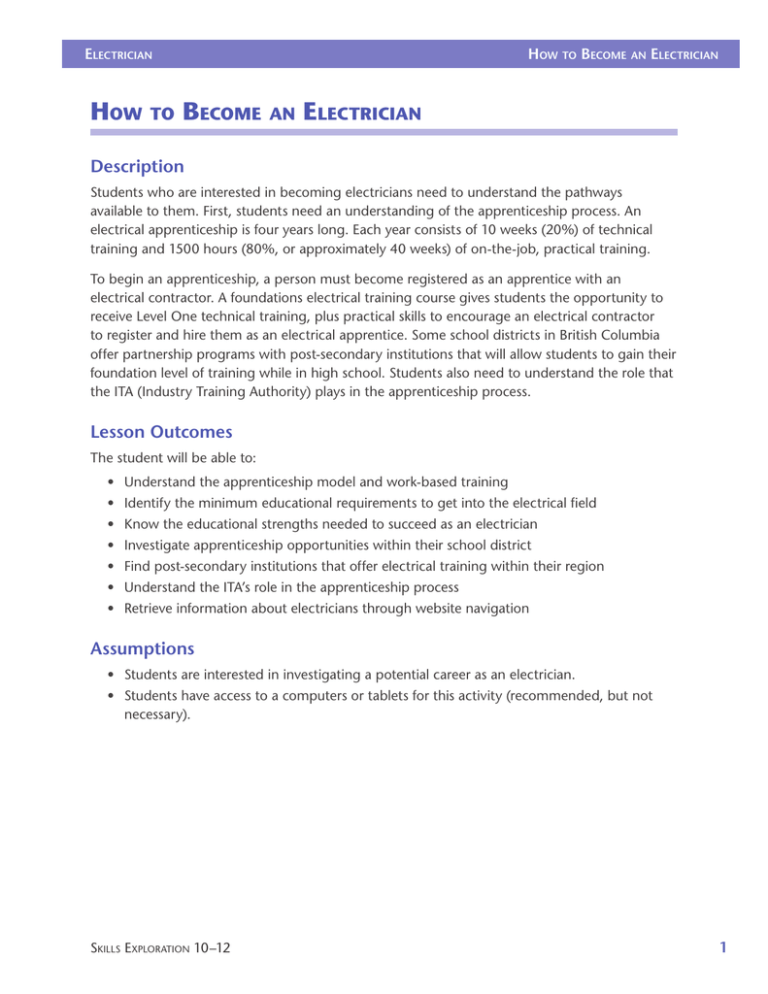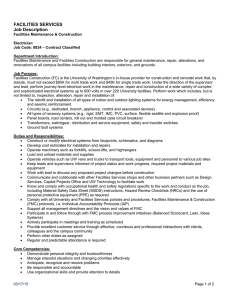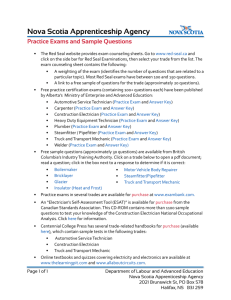How to Become an electrician
advertisement

Electrician How to How to Become an Electrician Become an Electrician Description Students who are interested in becoming electricians need to understand the pathways available to them. First, students need an understanding of the apprenticeship process. An electrical apprenticeship is four years long. Each year consists of 10 weeks (20%) of technical training and 1500 hours (80%, or approximately 40 weeks) of on-the-job, practical training. To begin an apprenticeship, a person must become registered as an apprentice with an electrical contractor. A foundations electrical training course gives students the opportunity to receive Level One technical training, plus practical skills to encourage an electrical contractor to register and hire them as an electrical apprentice. Some school districts in British Columbia offer partnership programs with post-secondary institutions that will allow students to gain their foundation level of training while in high school. Students also need to understand the role that the ITA (Industry Training Authority) plays in the apprenticeship process. Lesson Outcomes The student will be able to: • Understand the apprenticeship model and work-based training • Identify the minimum educational requirements to get into the electrical field • Know the educational strengths needed to succeed as an electrician • Investigate apprenticeship opportunities within their school district • Find post-secondary institutions that offer electrical training within their region • Understand the ITA’s role in the apprenticeship process • Retrieve information about electricians through website navigation Assumptions • Students are interested in investigating a potential career as an electrician. • Students have access to a computers or tablets for this activity (recommended, but not necessary). Skills Exploration 10–12 1 How to Become an Electrician Electrician Terminology Apprentice: someone who works for a skilled or qualified person in order to learn a trade or profession. Foundation program: allows students to learn the basic knowledge and skills needed for entry into a trade. It is typically taught in both the classroom and an in-school shop setting. You do not need an employer or sponsor to participate. Industry Training Authority (ITA): the organization responsible for leading and coordinating the skilled trades training and credentialing system for the province of BC. ITA provides strategic leadership, policy support, and customer services to help apprentices, employers, and industry. ITA sets program standards, maintains credential records, and issues the highly regarded Interprovincial Red Seal (IP) and BC Certificate of Qualification (CofQ) credentials. Interprovincial Red Seal and BC Certificate of Qualification: Through the Red Seal Program, certified tradespeople can obtain a “Red Seal” endorsement on their BC Certificates of Qualification. The Red Seal allows qualified tradespeople to practise their trade in any province or territory in Canada where the trade is designated, without having to write further examinations. See www.red-seal.ca for additional information on the Red Seal Program. Training providers: institutions that offer technical training. They must be approved by the ITA as an ITA-Recognized Training Provider, if the training is to be counted toward an apprenticeship. Work-based training: on-the-job training that requires specific learning outcomes. Electrical contractor: an employer or sponsor of electrical apprentices who provides workbased training for electrical apprentices. An electrical contractor is a business person or firm that performs specialized construction work related to the design, installation, and maintenance of electrical systems. Estimated Time 2–3 hours Recommended Number of Students 20, based on BC Technology Educators’ Best Practice Guide Facilities Computer lab with access to the internet or class set of tablets Teacher: Projector with computer and speakers, Internet access 2 Skills Exploration 10–12 Electrician How to Become an Electrician Tools Pen, pencil Materials Printed question sheet Optional If a class set of computers is not available, the teacher could lead a discussion about how to become an electrician using projector and laptop to navigate through websites and explain them. This could also be an opportunity to go on a field trip to a training provider and tour an electrical training facility. Resources 6 Steps to Success: Industry Training Authority http://www.itabc.ca/managing-apprentices/6-steps-success Industry Training Authority: Home Page http://www.itabc.ca WorkBC http://www.workbc.ca Career Trek BC http://www.careertrekbc.ca/ Apprenticeship Basics: Industry Training Authority http://www.itabc.ca/about-apprentices/apprenticeship-basics Skills Exploration 10–12 3 How to Become an Electrician Electrician Teacher-Led Activity Use a projector with computer to show the ITA website and explain the apprenticeship model: • Explain the apprenticeship process so students understand the apprenticeship model. See the “Apprenticeship Basics” link in the Resources section. The Red Seal Program is also explained on this page. • Go to the Youth in Trades section and then the Programs tab. This section explains the ACE IT and SSA programs. • Go to Trade Programs, find Electrician, Construction, and select it. Select Download Profile, which explains the apprenticeship pathway and educational requirements to become a construction electrician. • Find Our Trades Training System section and select Training Providers. This section shows all public and private training providers for trade programs. 4 Skills Exploration 10–12 Electrician How to Become an Electrician Student Activity Option 1: Informal activity: class set of computers or tablets is available In this informal activity, the teacher uses the “How to Become an Electrician” worksheet (on the next page) to ask students questions, while the students navigate through the WorkBC website to find answers. Option 2: Class set of computers or tablets is not available The teacher uses a projector and laptop to navigate through websites and leads a discussion about how to become an electrician. Students complete the “How to Become an Electrician” worksheet (on the next page) as the teacher moves through the sites. Option 3: “How to Become an Electrician” worksheet Students navigate through the WorkBC website and answer questions regarding the electrical trade using the “How to Become an Electrician” worksheet (on the next page). Evaluation Guidelines The student: • Actively participates in the activity (for Option 1 only) • Accurately completes the answer sheet (for Options 1 and 2 only) • Participates in class discussion • Participates in the optional extension activity Optional Extension Activity Students could create an account on the ITA website and, in the Discover Apprenticeship Programs section, select the ITA Essential Skills link to complete a free essential skills assessment. This assessment should take about an hour and should give the students a good idea of the skills they have and the skills they need to develop to become an electrician. Skills Exploration 10–12 5 How to Become an Electrician Electrician Worksheet: How to Become an Electrician Find out some facts about electricians. Use the website www.workbc.ca It’s time to do some Career Exploration. 1. Find the Career Profile for an electrician. The NOC (National Occupation Classification) number you are looking for is 7241. a. List the three main duties of an electrician. b.List five facts about electricians’ working conditions. c. How many weeks in total will an apprentice spend getting their educational training? 2. Answer the following two questions concerned with demographic information. a. What is the average full-time salary of a full-time electrician in the current workforce? b.What is the expected increase in employment in your region from 2010 to 2020? 6 Skills Exploration 10–12 Electrician How to Become an Electrician 3. Find the employment outlook in your region. What is the expected number of job openings in your region in the electrical trades and telecommunication occupations from 2010 to 2020? 4. Watch the Career Trek Video, episode 27, Electrician (link is at the bottom of the WorkBC page). a. What is the top wage per year made by electricians according to the video? a. What five skills are required to be an electrician? 5. Are there opportunities in your district for an electrical apprenticeship via partnership programs with post-secondary training institutions? Hint: Career educators or counsellors should be able to help with this question. Optional extension activity: Go to www.mytelus.com and search for two electrical contractors in your area. List them on this sheet. Skills Exploration 10–12 7 How to Become an Electrician Electrician Answers 1. a. Electricians perform some or all of the following duties: interpret drawings, circuit diagrams, and electrical code specifications for wiring layouts; pull wire through walls and floors; install brackets and hangers to support electrical equipment; install or repair various pieces of electrical equipment; splice, join, and connect wires to fixtures and components; test the continuity of circuits to ensure that an electrical system is safe and compatible; troubleshoot and repair faults in electrical systems; run preventive maintenance programs and keep maintenance records. See more at: http://www.workbc.ca/Job-Seekers/Career-Profiles/7241#section-duties b. Working conditions: Electricians typically work 40 hours per week and may occasionally work overtime. Workers are usually indoors, though the work area can often be noisy and dirty. Work may take place at heights or in confined spaces, and may require lifting of heavy objects. Safety is a big concern and precautions are followed to reduce the risks of injury from accidental electric shocks and falls from heights. See more at: http://www.workbc.ca/ Job-Seekers/Career-Profiles/7241#section-environment c. Educational training is typically 40 weeks. 2. a. Average salary $44,000–$53,000, or $26.00 per hour b. Answers will vary depending on the region. 3. Answers will vary depending on region. 4. a. $53,000 per year 8 b. Numerical ability, motor coordination, manual dexterity, spatial perception, detail-oriented Skills Exploration 10–12



